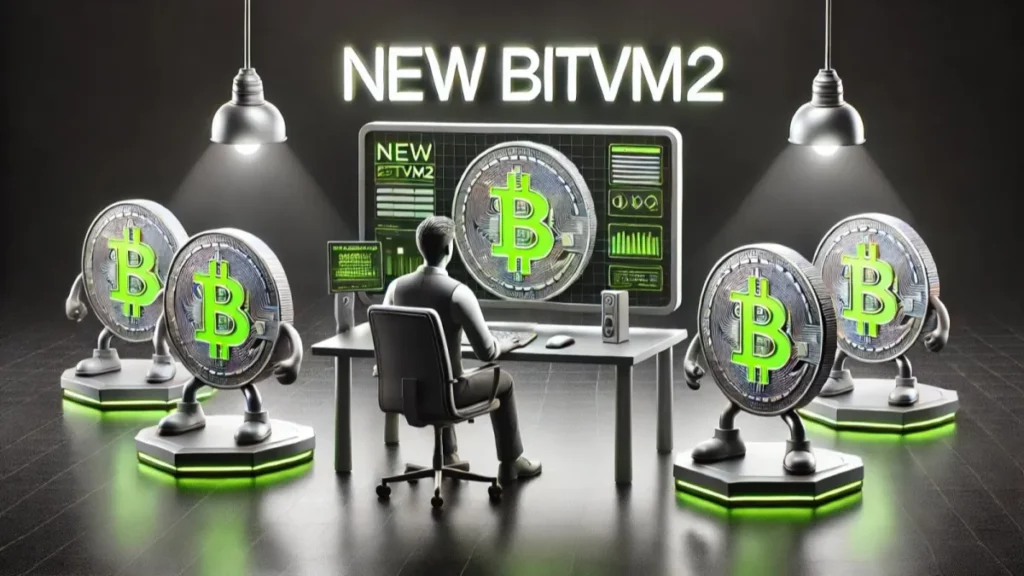
As a long-time observer, I believe this could be one of the most significant technological breakthroughs for Bitcoin since its inception in 2009.
Let’s start with a TLDR:
- BitVM2 is a major upgrade to BitVM, making complex computations on Bitcoin possible.
- BitVM Bridge is currently the most secure BTC bridge design, utilizing an innovative 1-of-n security model.
- These two technologies could revolutionize Bitcoin’s scalability, interoperability, and innovation space.
Now, let’s dive deeper into why these technologies are so exciting.
1. BitVM2: Turing-Complete Computation on Bitcoin
Imagine if you could run any complex program on Bitcoin—what would happen? That’s exactly what BitVM2 aims to achieve.
The core idea of BitVM2 is to perform complex computations off-chain while verifying fraud proofs on-chain. It’s like playing a “trust game” on Bitcoin. Everyone assumes the computation results are correct, but if someone cheats, anyone can step in and expose them.
This design cleverly achieves Turing-complete computation verification on Bitcoin’s limited scripting capabilities. It’s like giving Bitcoin a “super brain,” and this brain is decentralized!
2. BitVM Bridge: The Most Secure Bitcoin Bridge
Now, let’s look at BitVM Bridge, which could be the most secure BTC bridge design to date.
Currently, mainstream Bitcoin cross-chain solutions like Liquid Network and RSK rely on federated multi-signature systems.
BitVM Bridge introduces a new 1-of-n security model, meaning that as long as there is one honest participant, theft can be prevented. This design has the potential to significantly enhance the security and decentralization of Bitcoin cross-chain solutions, possibly becoming a key catalyst for the explosion of Bitcoin DeFi.
3. Potential Impact and Challenges
The emergence of BitVM2 and BitVM Bridge could fundamentally change our perception of Bitcoin:
- Scalability: BitVM2 brings Turing-complete computational capabilities to Bitcoin, meaning we can build more complex applications on it.
- Interoperability: BitVM Bridge creates a secure bridge between Bitcoin and other blockchains, significantly increasing Bitcoin’s liquidity and use cases.
- Innovation Space: These technologies provide developers with a new playground, and we can expect to see more innovative applications based on Bitcoin.
Of course, the widespread adoption of BitVM still faces challenges:
- Performance Issues: Although BitVM2 greatly simplifies the verification process, the gas cost for on-chain verification is still not low.
- Developer Ecosystem: Nurturing an active developer community takes time.
- Community Consensus: The conservative attitude of the Bitcoin community towards protocol layer changes might affect the approval of related soft fork proposals.
4. Future Outlook
The Bitcoin Layer 2 ecosystem is undergoing a silent revolution, centered around a competition between two paradigms: BitVM-based EVM Rollup and Bitcoin Restaking-based Babylon AVS. In this battle of paradigms, the emergence of BitVM2 and BitVM Bridge undoubtedly injects powerful momentum into the former.
It’s worth noting that Alexei, the co-founder of the EVM-compatible Rollup Bitcoin Layer 2 project BOB Network, is also a co-author of the BitVM2 paper. This fact not only highlights the close collaboration within the BitVM technical community but also suggests the significant improvements BitVM2 could bring to the EVM Rollup paradigm.
Looking ahead, the arrival of BitVM2 could significantly enhance the competitiveness of the BitVM-based EVM Rollup paradigm. It not only improves computational efficiency but also expands the range of achievable functions. This means that projects like BOB Network may soon offer a user experience and developer-friendliness comparable to Ethereum Layer 2s, while maintaining Bitcoin-level security.
Of course, the Bitcoin Restaking-based Babylon AVS paradigm cannot be overlooked. It offers a different security model and flexibility, which may be advantageous in certain scenarios. The competition between these two paradigms will drive rapid development and innovation across the entire Bitcoin Layer 2 ecosystem.
Conclusion
BitVM may be one of the most important technological developments in Bitcoin over the past decade. It not only expands Bitcoin’s capabilities but also paves the way for its integration with the broader blockchain ecosystem.
As investors and developers, we should closely follow developments in this area. BitVM and its derivative technologies may give rise to the next generation of innovative Bitcoin applications, injecting new vitality into this 15-year-old “antique.”